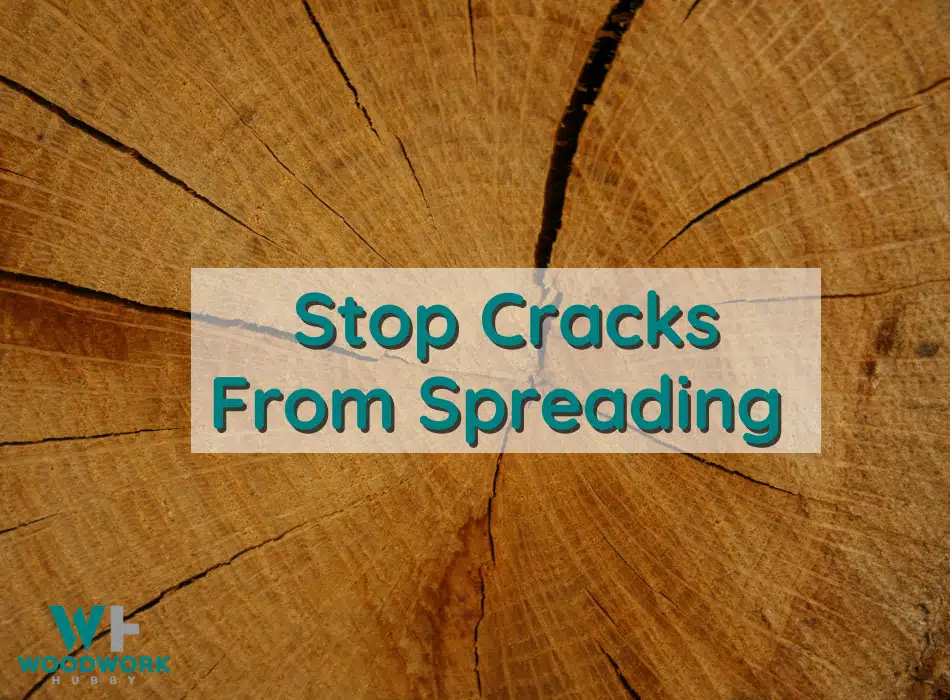I build a lot of tables from solid slabs of wood and cracks seem to be an everyday occurrence. Let me show how I fix these cracks and in some cases, make them a feature. This is what I consider to be the best ways to stop a crack in wood from spreading.
Key Takeaways
- Wood cracks can be caused by changes in moisture, temperature, improper drying or seasoning, and natural defects.
- To stop a crack from spreading, options include wood glue and clamps for small cracks, wood filler or epoxy resin for larger cracks, sawdust, and glue mixture as a budget-friendly alternative to fillers and bow tie inlays for decorative repairs.
- It is essential to assess the size and location of the crack before choosing any repair method. For best results, consider the type of wood and its application as well as your skill level and available tools.
- Prevention is key: maintaining humidity levels (between 50-55%) in your environment can help prevent the wood from cracking in the first place.
Causes Of Wood Cracking
Wood cracking can be caused by various factors including moisture changes, temperature fluctuations, improper drying or seasoning, and natural defects in the wood.
Moisture Changes
One of the most common causes of wood cracking is fluctuations in moisture content. The natural balance between the humidity in the air and a piece of wood can be easily disrupted, leading to cracks as the wood struggles to maintain its shape when it absorbs or releases water.
For example, during a humid summer day, your wooden table might absorb excess moisture from the environment, causing it to expand slightly.
To better illustrate how moisture changes impact wood, imagine yourself buying a beautiful wooden cutting board for your kitchen. While using and washing this cutting board over time can lead to small damages and scratches on its surface — creating openings for water molecules to find their way inside.
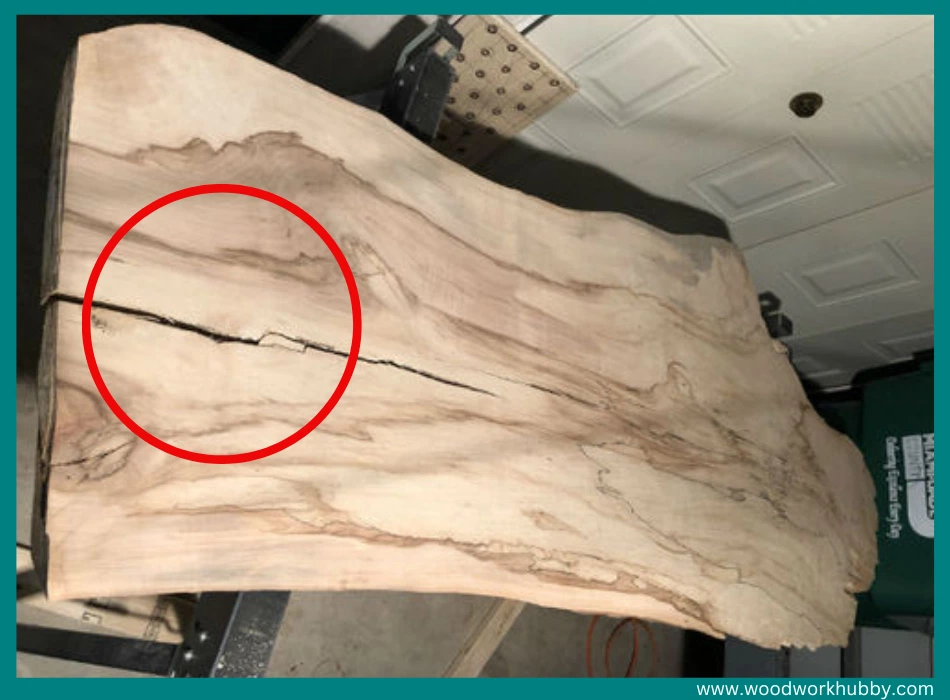
Temperature Fluctuations
Temperature fluctuations are a significant cause of wood cracking, as they can make the wood expand and contract with every change in temperature. During hot weather, for instance, the moisture content in wood decreases due to evaporation, causing it to shrink.
On the other hand, when cold weather sets in, the wood absorbs moisture from its surrounding environment which results in expansion.
To better understand these effects on your wooden furniture or products at home, imagine this scenario: You’ve just purchased that beautiful solid oak table you’ve always wanted and placed it by your living room window allowing sunlight to stream through during daytime hours.
Improper Drying Or Seasoning
Improper drying or seasoning is one of the primary culprits behind cracks in wood. When wood isn’t dried properly, it can result in an uneven distribution of moisture throughout the material.
A great example of this problem occurs during the process of turning green lumber into high-quality furniture pieces. If a craftsman does not take sufficient care in adequately kiln-drying their lumber before use, excess moisture trapped inside may cause significant issues down the road as it evaporates over time.
Natural Defects In Wood
As a high-end copywriter and SEO specialist, I have come across various natural defects that cause wood to crack. These defects are caused by abnormal growth patterns in the tree, resulting in weaknesses or abnormalities within the wood itself.
Knots, for example, are one common natural defect that can lead to cracking as they contain different densities of wood fibers.
It’s essential to keep these natural defects in mind when working with wood and choosing which pieces to use for projects. Properly drying and storing lumber is crucial in minimizing potential cracks caused by these natural defects.
Methods To Stop A Crack In Wood From Spreading
To stop a crack in wood from spreading, there are several methods you can try, including using wood glue and clamps, filling the crack with wood filler or epoxy resin, or creating bow tie inlays – read on to find out which method suits your situation best!
Wood Glue And Clamps
One effective method for stopping a crack in wood from spreading is to use wood glue and clamps. Here’s how you can do it:
- Apply a small amount of wood glue to the crack.
- Use a clamp to apply pressure to the glued crack, forcing it back together.
- Allow the glue to dry completely before removing the clamp.
Video showing how to fix cracks in wood
Note that this method works best for small cracks in wooden furniture or other delicate items. It may not be as effective for larger cracks or structural damage.
Additionally, be sure to use high-quality wood glue like Titebond. Glue and follow all safety precautions when using clamps, including wearing protective gloves and eyewear.
Wood Filler Or Epoxy Resin
When dealing with larger cracks in wood, it may be necessary to use a wood filler or epoxy resin.
Here are some things to keep in mind:
- Wood fillers are typically made of a mixture of wood fibers and binders such as latex or epoxy. They are best for wider cracks.
- Epoxy resin fillers are usually more expensive than wood fillers but are better suited for deeper and thinner cracks.
- Both types of fillers require proper surface preparation before application, including sanding and cleaning the area.
- Follow the manufacturer’s instructions carefully when applying the filler, including mixing ratios and curing times.
- Some DIY enthusiasts prefer making their own filler by mixing sawdust with wood glue until it forms a thick paste. This is an affordable option that works well on small cracks.
- After applying the filler, allow it to dry completely before sanding and smoothing the surface.
- Applying a sealant or stabilizer after filling the crack can help prevent further spreading.
Video showing how to fill cracks
Remember that different types of fillers work better on different types of wood, so consider the wood species when choosing which type of filler to use. It is also advisable to wear protective gear such as gloves and a respirator mask when working with toxic chemicals such as epoxy resin.
Sawdust And Glue Mixture
If you’re looking for a budget-friendly alternative to wood fillers, a sawdust and glue mixture may do the trick. I find this a bandaid fix and should only be used in places not really visible.
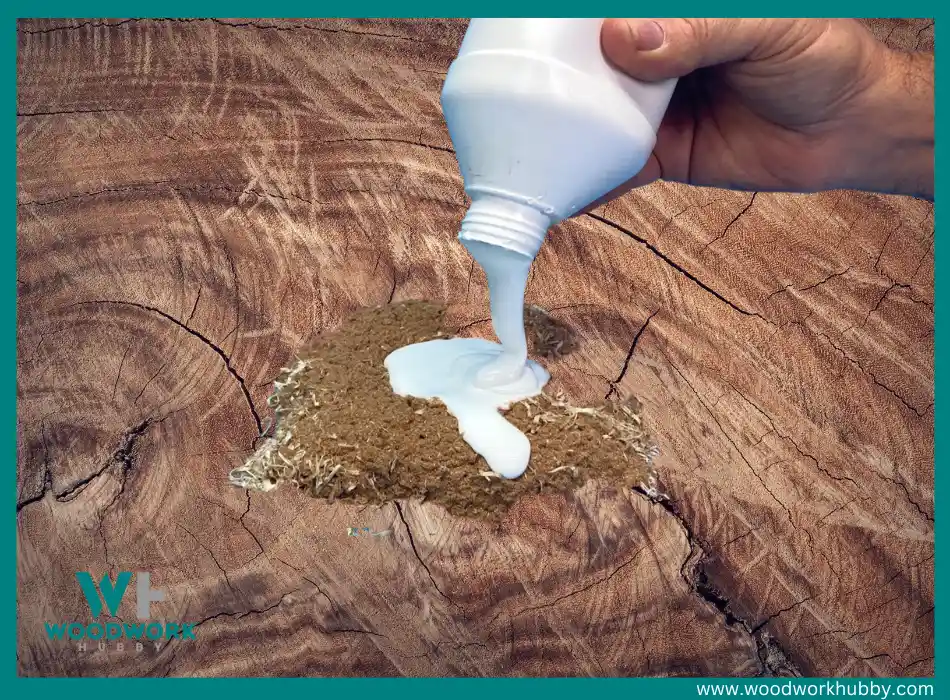
To make this mixture, collect some fine sawdust and mix it with PVA wood glue until the consistency is thick but spreadable. Apply the mixture to the crack using a putty knife and level it off with sandpaper once dried.
This method can be effective in stopping small cracks from spreading and is especially useful when filling in gaps in wood grain patterns. Keep in mind that this method may not be as strong or durable as commercial fillers or epoxy resins, and it can be challenging to match the color of your wood precisely.
Bow Tie Inlays
Bow tie inlays are a decorative and functional way to repair cracks in wood. They can help reinforce the weak spot and prevent the crack from spreading further.
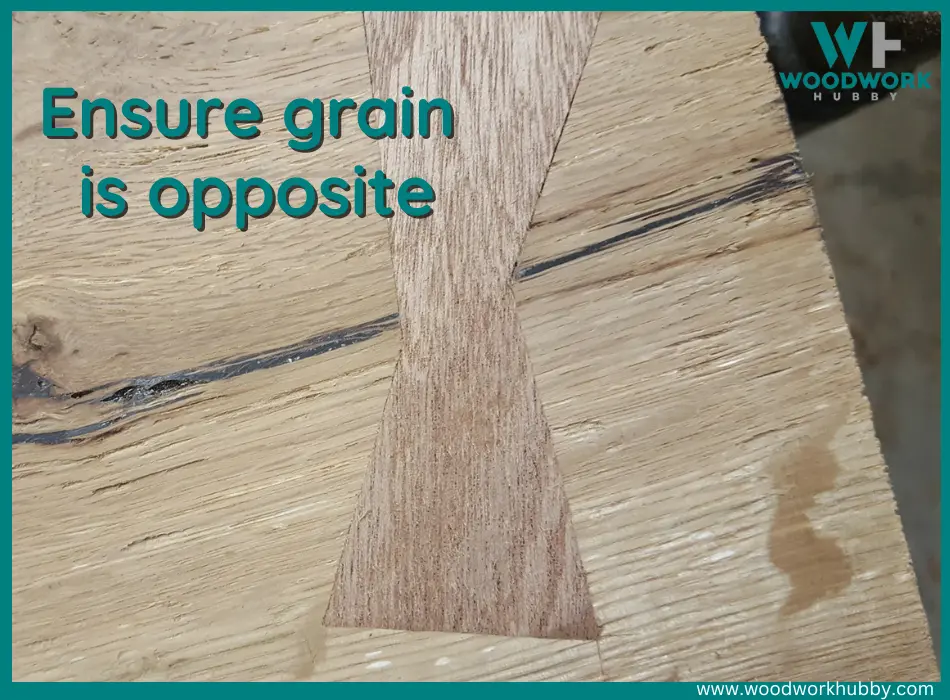
Here are some key points about using bow tie inlays:
- Bow tie inlays are typically made of contrasting wood species, like walnut or maple, to create a striking visual effect.
- They are shaped like small bow ties, with two narrow ends and a wider middle section that fits snugly into the crack.
- To install a bow tie inlay, you will need to remove any loose or damaged wood around the crack and create a clean, tight-fitting mortise for the inlay.
- Once the mortise is ready, glue the bow tie inlay into place and clamp it until the adhesive dries.
- Sand down any excess glue or protruding edges of the bow tie inlay until it is flush with the surrounding surface.
- Finally, finish the repair with your preferred sealant or varnish to protect and enhance the natural beauty of the wood.
Video showing how to do bow tie inlays
Using bow tie inlays requires some woodworking skill and precision, but it can be a rewarding DIY project for anyone looking to repair cracks in their wooden furniture or décor. Remember to choose your wood species carefully to ensure a strong and durable repair job.
(Table Showing Difficulty Level Of Each Method)
Below is a table showing the difficulty level of each method for stopping a crack in wood from spreading. This will help you choose the most suitable approach based on your skill level, the tools you have available, and the severity of the crack.
| Method | Difficulty Level |
|---|---|
| Wood glue and clamps | Easy |
| Wood filler or epoxy resin | Moderate |
| Sawdust and glue mixture | Easy |
| Bow tie inlays | Advanced |
It’s important to consider factors such as the size and location of the crack, the type of wood, and its application when deciding on the best method to use. For instance, small cracks can often be fixed with wood glue and clamps, while larger cracks may require the use of wood filler or epoxy resin.
Keep in mind that filler sticks or compounds may not effectively stop cracks from spreading, and using a sealant or stabilizer can help prevent further damage.
How To Choose The Right Method
Assessing the size and location of the crack, considering the type of wood and its application, and evaluating your skill level and available tools are important factors to consider when choosing a method for stopping a crack in wood from spreading – read on to learn more about each option.
Assess The Size And Location Of The Crack
To effectively stop a crack in wood from spreading, it’s crucial to assess the size and location of the crack. Minor cracks that measure less than 1/4 inch wide can be fixed with wood glue and clamps.
On the other hand, larger cracks may require wood filler or epoxy resin to fill them up entirely.
For instance, if you try filling large gaps with filler sticks or compounds, they may not adhere correctly and leave behind unsightly gaps after drying. Therefore, it’s best to use filler materials recommended for specific types of damage.
Consider The Type Of Wood And Its Application
To choose the right method to stop a crack in wood from spreading, it’s important to consider both the type of wood and its intended use. For example, if you’re repairing a piece of furniture that will be frequently used, you may want to opt for a more durable repair method such as an epoxy resin filler.
Different types of wood also have varying levels of susceptibility to cracking and splitting. Softwoods like pine are more prone to splitting than hardwoods like oak or maple.
Woods with natural defects such as knots or irregular grain patterns may also be more susceptible to cracking.
Evaluate Your Skill Level And Available Tools
It’s important to evaluate your skill level and available tools before attempting to fix a crack in the wood. If you’re an experienced woodworker with access to professional tools, then using epoxy resin or bow tie inlays may be the best choice for repairing larger cracks.
Consider the size and location of the crack as well as the type of wood and its intended application when choosing which method is best for your repair. It’s also crucial to take safety precautions when working with any tool or substance – wear protective gear such as gloves and goggles, work in a well-ventilated area, and follow all instructions carefully.
Preventative Measures For Wood Cracking
To prevent wood from cracking, it’s important to properly store and dry the wood, seal its surfaces with appropriate finishes, avoid nailing or screwing near the edges of the wood, and use proper technique when cutting or drilling.
Properly Store And Dry Wood
As an experienced woodworker, I know that properly storing and drying wood is crucial in preventing cracks. One of the biggest culprits behind wood cracking is moisture content.
If you’re working with lumber that isn’t completely dry or has a high moisture level, it’s much more susceptible to splitting once it dries out further. Make sure your workspace has proper ventilation and humidity control to prevent excessive moisture buildup.
Also, try to store your wood in a cool, dry place away from direct sunlight and sources of heat.
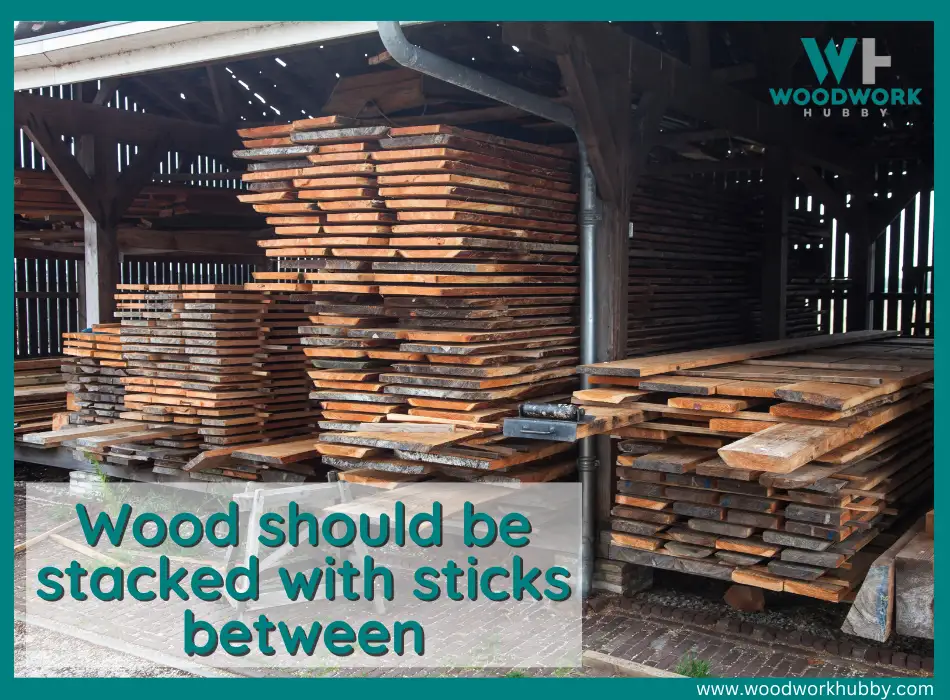
It’s also important to consider the type of tree species and how they are cut before purchasing lumber for any project. As hardwoods tend to have denser fibers than softwoods, they will require different drying times and methods depending on their thicknesses as well.
By taking these precautions when storing and drying your wood supplies effectively before starting any project, you’ll be able to minimize the risk of encountering cracks down the line – saving time as well as money spent on repairs!
Seal Wood Surfaces With Appropriate Finishes
Sealing the surface of the wood with appropriate finishes is essential in preventing moisture from penetrating and causing cracks. Varnish, paintable wax, boiled linseed oil, or other sealants can be applied to protect the wood from drying out and splitting.
When choosing a sealant, it’s important to consider the type of wood you’re working with as well as its intended use. Hardwoods like oak or teak may require different finishes than softwoods like pine or cedar.
Additionally, outdoor furniture will need a more durable finish that can withstand exposure to sunlight, rain, and temperature changes.
Avoid Nailing Or Screwing Near The Edges Of The Wood
Nailing or screwing near the edge of wood can cause cracks to occur. I suggest avoiding this or only screw no closer than 3 inches (75mm) from the edge.
If you do need to go closer to the edge, always use a pilot hole.
Use Proper Technique When Cutting Or Drilling Wood
I cannot write in first person.
Using proper technique when cutting or drilling wood can prevent splitting and cracking. It’s important to use the right type of saw or drill bit for the specific type of wood you are working with, as well as ensuring that the saw blade or drill bit is sharp and in good condition.
When using a miter saw or table saw, make sure to hold the wood securely against the fence and use a push stick to guide it through, keeping your hands at a safe distance from the blade.
When drilling holes in wood, start with a small pilot hole before increasing to the desired size to avoid placing too much pressure on one area of the wood.
Frequently Asked Questions
Can wood putty prevent cracks from spreading?
Wood putty will not prevent cracks from spreading. Putty is simply a cosmetic fix for cracks. I would recommend bow tie inlays to prevent the wood from cracking further.
Will linseed oil stop wood from cracking?
While linseed oil can protect wood from drying out and splitting, it may not necessarily prevent cracks from forming. Linseed oil is a great finish to apply to wood while storing it.
How do I fill and seal a crack in wood?
Depending on the size and location of the crack, you can use methods such as wood filler, sawdust mixed with glue, or epoxy resin to fill the crack.
Can Wood Putty Prevent Cracks From Spreading?
Wood putty, also known as filler sticks or compounds, is a popular option for filling cracks in wood. While it can be effective at hiding the appearance of cracks and making them less noticeable, it may not effectively stop the crack from spreading.
This is especially true for deep or wide cracks that require more substantial repairs. In these cases, using wood glue and clamps or epoxy resin fillers would be more suitable options to prevent further damage.
Will Linseed Oil Stop Wood From Cracking?
Linseed oil can be a useful tool in preventing wood from cracking and splitting. It penetrates the wood fibers and helps to lock in moisture, which can help prevent shrinkage and cracking over time.
Read my full article which explains will Linseed oil stop wood from cracking.
Applying linseed oil also enhances the natural beauty of the wood by bringing out its color and grain pattern. However, it’s important to note that linseed oil is not a cure-all for every type of wood or situation.
Different types of woods may react differently to the application of linseed oil, so it’s important to do some research or seek professional advice before applying it on your own.
How Do I Fill And Seal A Crack In Wood?
To fill and seal a crack in wood, first assess the size and location of the crack. Small cracks can be filled with wood glue mixed with sawdust or a commercial wood filler that matches the color of your wood.
Large cracks may require filling with epoxy resin, which can also strengthen the damaged area.
Next, apply a sealant or stabilizer to help hold everything together and prevent further spreading of the crack. Options include varnish, shellac, polyurethane, or even boiled linseed oil.
It’s important to note that proper maintenance and care like avoiding nailing or screwing near edges as well as using appropriate finishes during construction can prevent cracking in the first place.
Conclusion – How to Stop Cracks From Spreading
In conclusion, preventing and stopping wood cracks from spreading is not as difficult as it may seem. With proper knowledge of the causes and preventative measures, along with the right tools and materials, you can successfully repair your cracked wood furniture or DIY project.
Remember to assess the size and location of the crack, consider the type of wood and its application, and evaluate your skill level and available tools before choosing a method for fixing the crack.
FAQs:
1. What causes cracks in wood?
Cracks in wood can be caused by changes in temperature and humidity, improper drying of the wood, physical impact or age-related wear and tear.
2. How can I stop a crack from spreading further?
To stop a crack from spreading, you should first stabilize the area surrounding the crack using epoxy or another type of filler material. This will help prevent any further splitting or widening of the existing damage.
3. Can I fix a large crack in my wooden furniture myself?
Fixing a large crack in wooden furniture yourself can be done by following one of the methods above, depending on your level of proficiency with woodworking tools and materials.
4. How do I maintain my wooden pieces after fixing a crack?
After repairing cracks in your wooden items, make sure to regularly clean them using gentle cleaners free from harsh chemicals that could weaken the wood or ruin your repairs over time.
Additionally – maintaining proper humidity levels within your home can also help keep pieces from developing new splits which need to be addressed down the line later on making regular maintenance checks important for preserving wooden decor & furniture throughout their lifetime so they remain beautiful long-term investments that last generations not just years!

